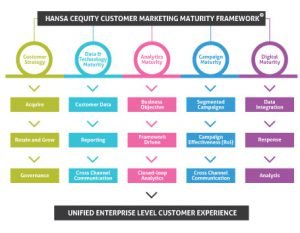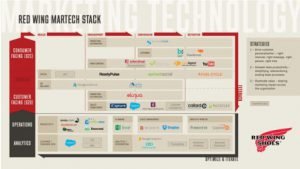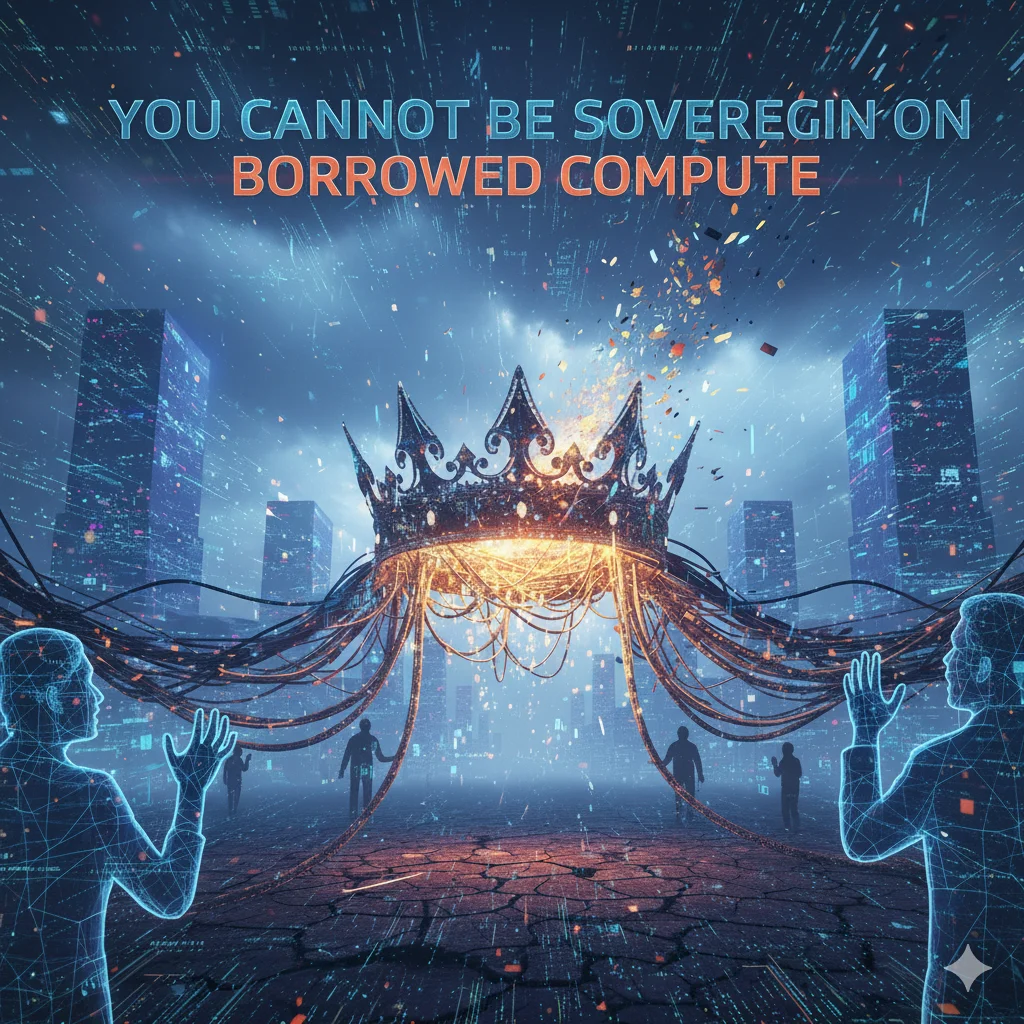Marketing technology platforms, also known as Martech tools and Martech stacks, are the buzzwords in the marketing world today. In some cases, it has been observed that marketing activities have been delegated to Martech stacks. In many areas, they are touted as differentiators. Right? Wrong? Or a mix of both? Well, the judgment is still out.
The fact is that Martech tools are here to stay. But the questions that need answers are: Which stack? One stack fits all – a single solution provider or point-based solutions?
There is a need to balance customer-centric ideas and technology-centric solutions. Self-service, personalization, contextual content, real-time communication, and geo-targeting are all customer-centric ideas. Integrated platforms, centralized systems, automation, economies of scale, ease of operations, and reporting are all technology-centric ideas.
The truth lies in imaginatively integrating customer-centric ideas with technology-centric Martech stacks to achieve impactful results.
Today, most organizations are grappling with making the right decisions in the context of marketing technology stacks. The reasons for this are many –
Are You Struggling with These Challenges While Choosing MarTech Tools?
-
Do you lack clarity on your business objectives?
-
Are complex customer journeys causing confusion?
-
Is there misalignment across your Marketing, Sales, Customer Service, Operations, and IT teams?
-
Are legacy systems, disjointed platforms, or redundant tools creating inefficiencies?
-
Is your budget either too constrained or too large, leading to random MarTech stack purchases?
-
Are you facing a shortage of skilled professionals to manage these platforms?
-
Who holds accountability for business outcomes and ensures executive sponsorship?
These are complex issues, and the challenges are only getting bigger by the day. Currently, 45% of marketers claim to have all the tools and fully utilize them in the Asia Pacific. If one looks at Europe and the US, the numbers are even lower. The adoption, we believe, is somewhere in between. MarTech stacks account for double-digit marketing budgets in some cases. CEOs are signing off on big fat checks because competition is doing it or looking at success benchmarks in overseas markets without taking local context into consideration. And then, the irony of it all: more than 30% of marketers don’t fully leverage the stacks that they have already bought!
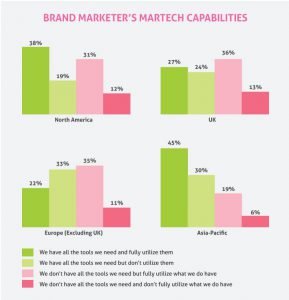
According to Avanade’s recent global research with SiteCore, MarTech stacks are failing customer experience like never before. In a study of 1,440 CIOs, CTOs, CMOs, and other senior marketing and IT decision-makers, 60% of the companies surveyed reported losing revenue because of digital marketing technology not working properly or a lack of collaboration between marketing and IT. 95% of organizations say their CX is in critical need of improvement, but they don’t know how to make it happen. In yet another study, 49% of marketers say their biggest challenge is leveraging technology to make data-driven decisions.
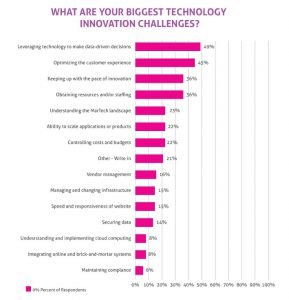
According to ChiefMarTech, there are more than 7,000 different marketing technologies available for marketers to choose from! Almost every day, new players are entering the market with a plug-in or solution. Even the big players are acquiring products and adding to their suite to meet the ever-growing needs. It is impossible for a marketer to keep track and make informed decisions. Developments in analytics, DMPs, DSPs, and CRMs allow for much more sophisticated, personalized, targeted, and real-time communication and customer experiences. The question, in our view, is one of integration and orchestration of multiple systems.
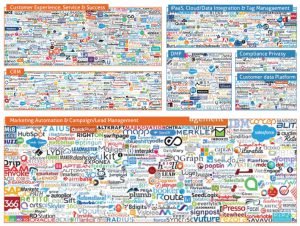
No doubt, investing in marketing technology is a business imperative. Marketers need to think about it differently. Next-gen communication is demanding a whole new way of marketing and a complete change in mindset and marketing processes. Marketing technology has to be business value-generating. It needs to integrate and aid customer journeys, helping discover more insights that will drive business intelligence and enhance the customer experience across all channels and touchpoints. The progression of marketing technology solutions has been gradual—from CRM-based database marketing to automation and campaign tools to marketing platforms to the current age of enterprise marketing software suites. The transition has been chaotic and has raised more questions than answers. Additionally, the marketer is no longer a cost center. She needs to align all goals toward meeting business objectives and generating ROI. How does a marketer effectively navigate this complex and intriguing web of decisions? The journey starts with aligning business metrics with MarTech goals.
ALIGNING BUSINESS METRICS WITH MARTECH GOALS
This must be the starting point of any MarTech discussion. In a study done by Gartner 46% of CMOs stated that new technology must lead to Revenue growth. Business might use different kinds of marketing technology platforms – DMPs, Ad platforms, Marketing Platforms, 24/7 marketing to drive real time engagement, Analytics and campaigns, Intelligence lead engagement to drive next best product and trigger next best action but all of them at the end of the day must be measurable.
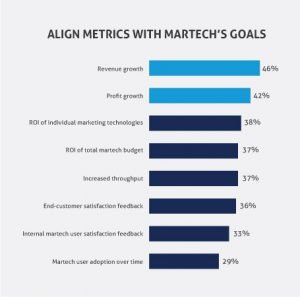
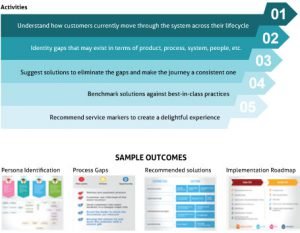
Understanding the Marketing Maturity of the Organization
Different organizations are at different stages of maturity, and it is important to understand the level of maturity they are in before embarking on a MarTech journey. Businesses are eager to transform from ROI to ROC (Return on Customer), from fragmented and different data sources to a unified single view, from dark mystery data to analyzing all data points, from carpet bombing mass communication to 1:1 personal communication, and from having a fragmented digital presence to an integrated digital presence. It is imperative to understand the maturity level and make these MarTech investments accordingly. The Hansa Cequity Customer Marketing Maturity Framework assesses the level of customer marketing maturity of an organization. This is measured across five functions: Customer Strategy, Data and Tech Maturity, Analytics Maturity, Campaign Maturity, and Digital Maturity. It enables marketers to get a realistic assessment of where they stand.
Customer Strategy
Having well defined customer goals is key. Customer strategy is central to any solution. Clear customer segments need to be identified. The segments must be aligned with business objectives. A detailed understanding of the segment behaviour needs to be articulated and incorporated as a key input in the customer data. Also, the sources of different data available in the enterprise must be mapped and the quality of data must be assessed. Most customer journeys are broken and fragmented due to data silos. There is a need for persona identification, understanding how they move through the system currently, identifying gaps in the process, delivering and customer experience, recommending integrated data management solutions that can talk to each other in real time and exchange information and benchmark best practices that drive the organization toward intelligent customer interaction and experience leading to greater ROI.
Data and Tech Maturity
A clear data stewardship program needs to be a part of the framework and creating an organization wide data governance process and appreciation of data quality to every stakeholder in the organization is key.
Analytics Maturity
Align with organisational objectives and KPIs. KPIs to analytics is very important. There is a need to develop an analytics framework & solution that aids decision making across acquisition, retention, and customer growth across marketing, sales, operations, finance, HR and they need to work in tandem to help achieve the business and customer goals. There is a need for a shared business agenda and outcome within the analytics and realistic assessment of current state of collaboration for data-driven decision making in the organization.
Campaign Maturity
With the advent of technology in marketing, it is often said ‘imagine doing marketing as if it were customer service’. There is a need to build a ‘sense and respond’ culture with the customer facing team to realign marketing process for campaigns across touch points. Again, a clear assessment of how the different departments need to work together for a ‘to-be’ state from ‘as-is’ state post campaign automation is key.
Digital Maturity
Customers expect a unified experience across different digital channels and even the difference between offline and online has blurred. Ensure that the digital channel is built into the enterprise strategy. Seamless integration of digital with offline channels and vice-versa and tracking digital interaction while personalizing digital experience is key to this transformation. All digital journeys and movement from physical to digital and digital to physical must be mapped and the need to make it possible is essential. A benchmark of current digital operations and process across various channels is an important step to take. All interventions in the digital journey must be captured. Need to make the online, offline and multi-channel as integrated as possible. Once you have done all of this, the softer and one of the most difficult part of the process commences.
Understanding, Aligning and Collaborating with Key Internal Stakeholders
It is often said, “culture eats strategy for breakfast.” The CEO-CMO-CIO trio must foster a culture of collaboration and alignment to ensure the success of their MarTech tools and strategies. Together, they must work in unison to build a robust and effective MarTech stack.
For this collaboration to work seamlessly, the customer feedback loop, organization feedback loop, and market feedback loop must be highly agile. Development sprints need to be short, course corrections should be immediate, and experiments must remain ongoing.
None of this is possible without strong collaboration among the CEO, CMO, and CIO. Embedding a culture of collaboration, aligning interdependent KPIs, and instituting governance mechanisms into operating processes are critical to leveraging MarTech tools effectively and driving organizational success.
Let’s Look at a Best-in-Class MarTech Stack Example
A great example is Red Wing Shoes – a 110-year-old business headquartered in Red Wing, Minnesota. Red Wing boots protect workers in more than one hundred countries worldwide, an accomplishment built on years of hard work, endurance, and the promise to never compromise on quality. The MarTech stack used by Red Wing Shoes is comprehensive, capturing the entire customer journey and creating seamless loops that connect back to different organizational systems and stakeholders. It simplifies and demystifies the role of MarTech tools in aligning with business strategies.
The Red Wing Shoes MarTech stack is simple and efficient. It clearly articulates strategies for personalization, productivity, scalability, standardization, and driving business value. It showcases how MarTech tools are leveraged for operations and analytics in a consumer brand, particularly one that interacts with both B2B and B2C customers.
The stack illustrates the entire journey from reach → engagement → conversion → retention → feedback loop, which is used to iterate and optimize processes. It seamlessly integrates customer data, a Customer Data Platform (CDP), and a Data Management Platform (DMP) for second- and third-party data. It supports campaign planning, campaign dashboards, analytics, and forecasting. From marketing automation to sales enablement, and from ad delivery to social and web content, the MarTech stack integrates 32 different marketing solutions. This robust setup vividly captures the entire customer journey and contextualizes technology usage, making it a powerful tool for achieving business goals.
The Hansa Cequity MarTech Evaluation Framework
As mentioned earlier, there is no one size that fits all. Each organisation will have to embark on its own unique MarTech framework, maturity and journey. The means and tools will be different but the end objective is the same – Driving business value through customer centricity.
In this context, find below a MarTech evaluation framework that will help organisations understand their current state, assess tools and technology and embark upon a journey of driving business value through the confluence of product, service, data and technology leading to unmatched customer experience.
A Comprehensive Guide to Building and Implementing Effective Martech Tools and Strategy
DESIGN: Crafting the Right Framework for Your MarTech Tools
- Design a model that is unique to your business needs.
- Ensure that all solutions can be integrated seamlessly.
- Automate as many processes as possible to improve efficiency.
- Leave room for plug-and-play flexibility; let technology be an enabler, not a constraint.
- Simplify and demystify processes; secure buy-in from all leaders, including the CEO.
DEVELOP: Creating Robust and Scalable MarTech Stacks
- Develop the primary solution alongside alternative solutions.
- Explore all tech stacks—integrated or point-based solutions.
- Iterate and conduct multiple experiments, including proof of concepts (POCs).
- Test the system’s robustness to ensure reliability.
- Ensure the system’s ability to integrate new developments, tools, and APIs.
- Have a backup plan in case of unexpected failures.
- Build skills within the organization in technology, data, analytics, and experiential areas.
DRIVE: Leadership and Continuous Innovation in MarTech Strategy
- Nominate a dedicated MarTech leader to oversee initiatives.
- Re-evaluate strategies and tools regularly to stay competitive.
- Encourage innovation by adopting Agile processes.
DISCOVER: Identifying Gaps and Opportunities with MarTech Tools
- Understand the current organizational maturity level in adopting MarTech tools.
- Connect with multiple business processes to ensure alignment.
- Identify needs and gaps in the customer journey for improvement.
- Discuss with current users of the tools and platforms to gain insights.
- Map and understand all data sources for comprehensive analysis.
DETERMINE: Evaluating the Right MarTech Solutions for Your Business
- Consult with integrated and multiple stack providers.
- Engage with service providers for expert advice.
- Seek opinions from users of existing stacks outside your organization.
- Evaluate possible platforms and solutions to make informed decisions.
DEPLOY: Implementing and Optimizing Your MarTech Strategy
- Deploy the platform in a phased manner for smoother adoption.
- Develop strong governance and data privacy processes to maintain compliance.
- Establish KPIs for each process to measure effectiveness.
- Monitor every aspect of the system to ensure ongoing optimization.
The Customer Marketing Maturity (CMM) assessment and MarTech Evaluation framework are just the beginning, but they put organizational needs in context vis-à-vis business goals. It is a long journey that requires leadership, collaboration, and culture change. Whether organizations like it or not, they will have to embark on this journey. The change must start at the top but needs to resonate throughout the organization, as that’s where the rubber meets the road. A Customer Marketing Maturity (CMM) and MarTech Evaluation framework should serve as guiding principles, not written in stone. It must be flexible and account for technological complexities and evolutions or shifts in business strategy.
In this entire process, the most underestimated effort is change management. It is relatively easier to change technology and systems, but getting people to modify their behavior or habits is a fundamental challenge. Leadership must drive this. Aligning senior management, effectively communicating the need for change, fostering collaboration, and driving this change toward successful implementation are critical aspects of the evaluation and decision-making process.
Finally, What Do Marketers Really Want from Their MarTech Tools?
Marketers seek simplicity and measurable business results from their MarTech tools. They desire the flexibility to add, delete, and modify the architecture to stay current. They need to measure business impact and are willing to pay the right price for the right value when customers can feel the difference in their pre-purchase and post-purchase ownership experience. That’s when enterprises will truly value the MarTech tools they have invested in.
Scott Brinker: ‘I agree that most companies only use a tiny fraction of their tools. That’s partly because marketing leaders have the least time to understand the tools to see what experiments can be run. The ability to match insights to existing tool capabilities exists further down the organization, which is why you need to implement agile processes and ways of working so people at a lower level can experiment within a framework without creating chaos. You need to allow them to push forward and work with these tools to understand what they’re capable of. That’s when you can find new value pretty quickly.’
References:
• CX magazine – https://cxm.co.uk/cx-and-marketing-tech/
• Marketing Sherpa – https://www.marketingsherpa.com/article/chart/biggest-technology-innovation- challenges ; study done by Marketing Sherpa and Source Fuse,
• Chiefmartech – https://chiefmartec.com/2018/04/54-marketing-stacks-stackies-2018-marketing-tech -stack-awards/
• McKinsey – https://www.mckinsey.com/business-functions/marketing-and-sales/our-insights/making -the-most-of-marketing-technology-to-drive-growth
• cnswire https://www.cmswire.com/digital-marketing/what-is-the-cmos-technology-strategy-for-2019 -and-beyond/
• Gartner – 2018 Gartner Marketing Technology survey


